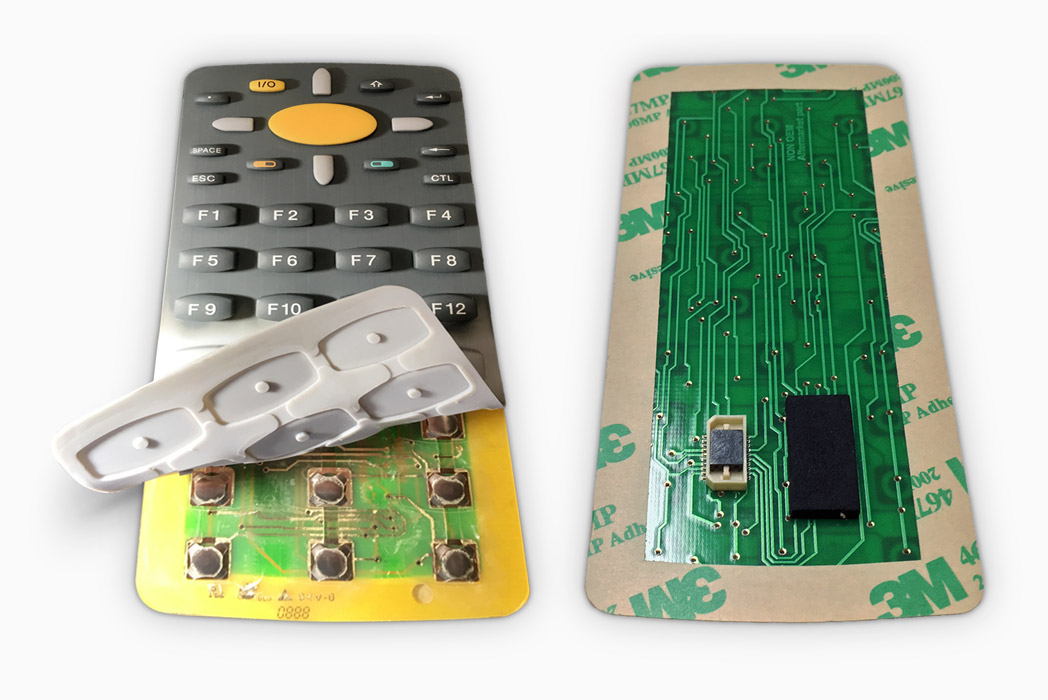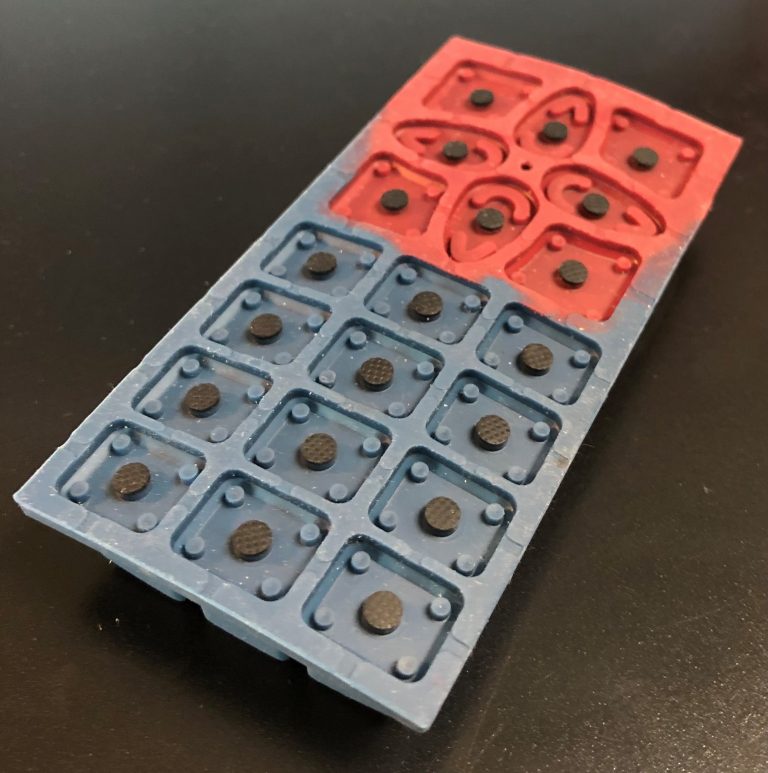The upcoming innovations of Rubber Keypads: smart features
Wiki Article
Discovering the Manufacturing Process Behind Rubber Keypads and Their Significance in Modern Devices
Rubber keypads are crucial in the performance of modern-day tools. Their production procedure includes cautious selection of products and precise strategies. Keypads are created to boost individual interaction while guaranteeing resilience and reliability. Understanding just how these components are made reveals their relevance across different applications. What variables add to their performance, and just how do these components affect customer experience? The solutions may improve assumptions of this day-to-day technology.Summary of Rubber Keypads and Their Applications

Rubber keypads are functional components extensively utilized in different digital devices, ranging from customer electronics to commercial equipment. Their design enables for a tactile action, making them an ideal choice for applications calling for user communication. Generally discovered in items such as push-button controls, calculators, and medical devices, rubber keypads assist in convenience of use and accessibility.
In industrial setups, they offer critical functions in equipment and control panels, where resilience and resistance to ecological aspects are vital. The non-slip surface enhances grasp, promoting dependability sought after conditions. Furthermore, their lightweight nature and adjustable forms allow makers to create customized services that fit details demands. With advancements in innovation, rubber keypads proceed to develop, including features like backlighting and improved level of sensitivity. In general, their adaptability and practical advantages add significantly to the performance of different devices across several markets.
Materials Used in Rubber Keypad Production
Keypad making relies on an option of materials that enhance both performance and sturdiness. The primary material used in the production of rubber keypads is silicone rubber, known for its superb resilience and versatility. This material allows keypads to stand up to duplicated pressing without shedding form or efficiency. In addition, polycarbonate elastomers (TPE) are frequently used because of their ease of molding and capability to supply a soft-touch feel.Tinting agents, such as pigments, are included to guarantee vibrant, lasting hues that boost aesthetic appeal. Moreover, ingredients like anti-UV agents and fire resistants may be blended into the rubber to improve climate resistance and security conformity. The option of products straight influences the keypad's tactile action, longevity, and overall efficiency in various tools. Eventually, the cautious option of these elements is crucial for the manufacturing of top notch rubber keypads that meet customer and sector demands.
The Design Refine of Rubber Keypads
When producing rubber keypads, the layout process plays a vital role in figuring out performance and customer experience. Developers start by defining the keypad's meant usage, considering elements such as the device it will certainly go along with and the target customer demographic. This preliminary phase includes sketching formats that focus on ergonomic facets, making certain the tricks are easily accessible and properly spaced.Next off, designers concentrate on the tactile responses preferred from the keypads, which affects the choice of products and key shapes. Prototyping is important in this stage, enabling developers to examine various styles for comfort and responsiveness.

Production Techniques for Rubber Keypads
The production procedure for rubber keypads includes a collection of accurate techniques that assure high quality and functionality. Liquid silicone rubber (LSR) is often utilized due to its resilience and flexibility. The process begins with blending the raw materials, consisting of silicone, colorants, and treating agents. This mix is then infused into mold and mildews made to shape the keypads precisely.
Following injection, the shaped keypads undergo healing, a heating procedure that solidifies the product (Rubber Keypads). This is commonly performed in a press, ensuring the keypads attain the preferred solidity and durability
Quality Assurance Steps in Manufacturing
To assure that rubber keypads satisfy high requirements of high quality and functionality, extensive high quality control procedures are implemented throughout the production process. These measures begin with raw material examination, ensuring that only the highest-grade elastomers are utilized. Throughout the production stage, operators conduct regular checks to monitor parameters such as temperature level, stress, and mixing times, critical for attaining constant item top quality.Post-production, each batch of keypads undertakes detailed screening, consisting of tactile feedback assessments and sturdiness tests to evaluate performance under numerous conditions. Visual inspections are likewise performed to recognize any defects, such as bubbles or inconsistencies in texture. Additionally, conformity with sector criteria is verified, making sure that the keypads meet safety and security and functionality benchmarks.
The Duty of Technology in Keypad Growth
look at this site Technology plays a vital role in the advancement of rubber keypads by making it possible for advanced production methods that enhance accuracy and efficiency. In addition, cutting-edge product selection permits for improved longevity and responsiveness in keypad performance. These improvements not only streamline manufacturing yet also elevate the overall top quality of the end product.Advanced Manufacturing Techniques
Advancements in manufacturing strategies revolutionize the production of rubber keypads, improving both efficiency and precision. Technologies such as injection molding and 3D printing have actually transformed conventional procedures, allowing suppliers to create complicated styles with minimized waste and enhanced turnaround times. Automation plays a necessary duty in this evolution, enhancing production line and decreasing human error. Additionally, computer-aided design (CAD) software permits for intricate modification, making sure that keypads satisfy particular customer needs. Quality control actions have also progressed, including real-time surveillance systems that find problems early in the manufacturing cycle. These innovations not just boost the sturdiness and performance of rubber keypads but also support the expanding demand for personalized solutions in different industries, from customer electronics to automobile applications.Cutting-edge Material Selection
The advancement of producing strategies has led the way for innovative product choice in rubber keypad advancement. Advances in polymer science have actually presented materials that boost toughness, flexibility, and responsive responses. Suppliers currently use polycarbonate elastomers (TPE) and silicone compounds, which give superior resistance to wear and ecological variables. These products enable the production of keypads that can sustain extended usage while keeping aesthetic charm. Furthermore, the integration of additives and layers improves functionality, such as boosting grasp and minimizing friction. The option of products is vital, as it straight affects the efficiency and durability of keypads in different devices, from consumer electronics to industrial equipment. This ingenious approach remains to shape the future of keypad layout and usability.The Influence of Rubber Keypads on Individual Experience
Rubber keypads significantly affect user experience through their boosted tactile action, which enables for even more accurate communication. In addition, their toughness and long life add to regular efficiency with time, lowering the requirement for frequent replacements. This combination of features makes rubber keypads a favored option in numerous applications, eventually impacting user contentment.Enhanced Tactile Response
Enhancing responsive response substantially influences user experience, especially in devices that depend on keypads for communication. Rubber keypads provide a special mix of gentleness and durability, enabling customers to feel distinctive comments with each press. This feedback enhances a feeling of control and accuracy, important in applications ranging from mobile phones to industrial equipment. Customers often report higher fulfillment and efficiency when engaging with devices that feature properly designed rubber keypads, as they help with quicker and a lot more exact input. Furthermore, the ergonomic design of these keypads can minimize finger tiredness, advertising longer use durations without discomfort. On the whole, the improved responsive response provided by rubber keypads considerably adds to an extra instinctive and pleasurable customer experience in modern innovation.Durability and Long life
A crucial facet of customer experience with rubber keypads hinges on their longevity and durability. These keypads are developed to withstand extensive use, withstanding wear and tear that usually influences other products. The durable nature of rubber warranties that keypads keep their capability and look in time, which is essential for gadgets often used in various settings. Customers take advantage of the dependability of rubber keypads, as they can withstand direct exposure to temperature, dirt, and wetness fluctuations without wearing away. This resilience not click over here now just enhances customer contentment however also decreases the need for frequent substitutes, inevitably adding to cost-effectiveness for producers. Basically, the durability of rubber keypads substantially affects the total efficiency and user experience in modern-day tools.Often Asked Concerns
Exactly How Lengthy Do Rubber Keypads Typically Last in Gadgets?
Rubber keypads typically last between 5 to one decade, depending on usage, ecological elements, and high quality of materials made use of (Rubber Keypads). Routine deterioration can reduce their life expectancy, affecting functionality and user experience over timeCan Rubber Keypads Be Customized for Particular Applications?
Rubber keypads can without a doubt be customized for details applications, enabling alterations in dimension, structure, shape, and shade. This flexibility allows manufacturers to develop tailored solutions that fulfill varied customer requirements and improve capability in different tools.Are Rubber Keypads Eco-friendly?
Rubber keypads are commonly ruled out eco-friendly due to their petroleum-based materials. However, developments in hop over to these guys lasting production methods and the growth of bio-based choices are progressively improving their ecological impact in numerous applications.What Are Usual Problems Faced Throughout Rubber Keypad Production?
Usual concerns encountered throughout rubber keypad production consist of irregular material top quality, mold flaws, incorrect curing times, adhesion failures, and challenges in achieving precise responsive responses. These troubles can lead to reduced item efficiency and customer frustration.Exactly How Do Rubber Keypads Contrast to Various Other Kinds Of Trick Switches Over?
Rubber keypads supply a softer feeling and quieter operation compared to mechanical buttons, which give responsive feedback. Nevertheless, rubber keypads may break faster and lack the accuracy that some users like in high-performance applications.The primary material made use of in the manufacturing of rubber keypads is silicone rubber, recognized for its excellent durability and versatility. When developing rubber keypads, the design process plays a necessary function in figuring out performance and customer experience. Rubber keypads substantially influence individual experience with their boosted tactile response, which permits for even more specific interaction. Individuals frequently report higher complete satisfaction and efficiency when interacting with gadgets that feature well-designed rubber keypads, as they promote quicker and a lot more exact input. An essential aspect of user experience with rubber keypads exists in their toughness and long life.
Report this wiki page